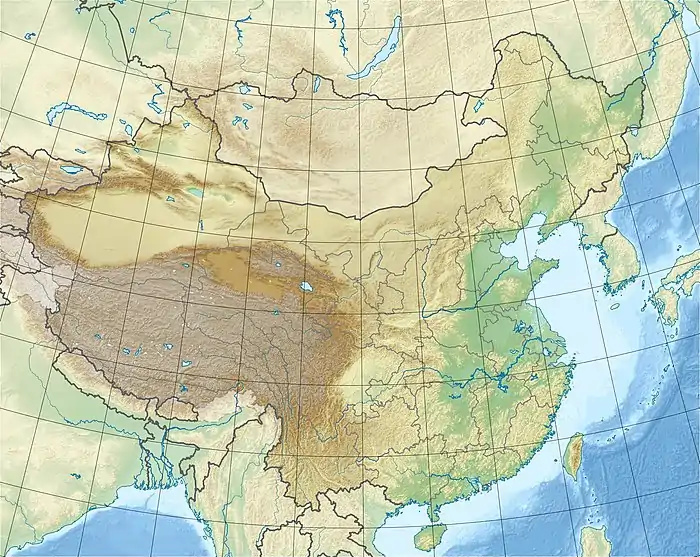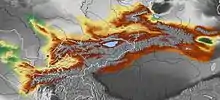Tian Shan
The Tian Shan,[note 1] also known as the Tengri Tagh[1] or Tengir-Too,[2] meaning the Mountains of Heaven or the Heavenly Mountain or Mountains of God, is a large system of mountain ranges in Central Asia. The highest peak in the Tian Shan is Jengish Chokusu, at 7,439 metres (24,406 ft) high. Its lowest point is the Turpan Depression, which is 154 m (505 ft) below sea level.[3]
| Tian Shan 天山 | |
|---|---|
| Tengri Tagh, Tengir-Too | |
 The Tian Shan range on the border between China, Kazakhstan and Kyrgyzstan with Khan Tengri (7,010 m) visible at center | |
| Highest point | |
| Peak | Jengish Chokusu |
| Elevation | 7,439 m (24,406 ft) |
| Coordinates | 42°02′06″N 80°07′32″E |
| Geography | |
.png.webp)  | |
| Countries | China, Kazakhstan, Kyrgyzstan, Uzbekistan and Tajikistan |
| Range coordinates | 42°N 80°E |
| Geology | |
| Age of rock | Mesozoic and Cenozoic |
| Official name | Xinjiang Tianshan |
| Type | Natural |
| Criteria | vii, ix |
| Designated | 2013 (37th session) |
| Reference no. | 1414 |
| Region | Asia |
| Official name | Western Tien-Shan |
| Type | Natural |
| Criteria | x |
| Designated | 2016 (40th session) |
| Reference no. | 1490 |
| Region | Asia |
One of the earliest historical references to these mountains may be related to the Xiongnu word Qilian (traditional Chinese: 祁連; simplified Chinese: 祁连; pinyin: Qílián) – according to Tang commentator Yan Shigu, Qilian is the Xiongnu word for sky or heaven.[4] Sima Qian in the Records of the Grand Historian mentioned Qilian in relation to the homeland of the Yuezhi and the term is believed to refer to the Tian Shan rather than the Qilian Mountains 1,500 kilometres (930 mi) further east now known by this name.[5][6] The Tannu-Ola mountains in Tuva has the same meaning in its name ("heaven/celestial mountains" or "god/spirit mountains"). The name in Chinese, Tian Shan, is most likely a direct translation of the traditional Kyrgyz name for the mountains, Teñir Too.[1] The Tian Shan is sacred in Tengrism, and its second-highest peak is known as Khan Tengri which may be translated as "Lord of the Spirits".[7] At the 2013 Conference on World Heritage, the eastern portion of Tian Shan in western China's Xinjiang Region was listed as a World Heritage Site.[8] The western portion in Kazakhstan, Kyrgyzstan, and Uzbekistan was then listed in 2016.[9]
Geography
Tian Shan is north and west of the Taklamakan Desert and directly north of the Tarim Basin in the border region of Kazakhstan, Kyrgyzstan, Uzbekistan and Xinjiang in Northwest China. In the south it links up with the Pamir Mountains and to north and east it meets the Altai Mountains of Mongolia.
In Western cartography as noted by the National Geographic Society, the eastern end of the Tian Shan is usually understood to be east of Ürümqi, with the range to the east of that city known as the Bogda Shan as part of the Tian Shan. Chinese cartography from the Han Dynasty to the present agrees, with the Tian Shan including the Bogda Shan and Barkol ranges.

The Tian Shan are a part of the Himalayan orogenic belt, which was formed by the collision of the Indian and Eurasian plates in the Cenozoic era. They are one of the longest mountain ranges in Central Asia and stretch some 2,900 kilometres (1,800 mi) eastward from Tashkent in Uzbekistan.[3]
The highest peak in the Tian Shan is Jengish Chokusu (also called Victory Peak) on the Kyrgyzstan-China border. At 7,439 metres (24,406 ft) high, it is the highest point in Kyrgyzstan.[3] The Tian Shan's second highest peak, Khan Tengri (King Heaven), straddles the Kazakhstan-Kyrgyzstan-China tripoint and at 7,010 metres (23,000 ft) is the highest point of Kazakhstan. Mountaineers class these as the two most northerly peaks over 7,000 metres (23,000 ft) in the world.
The Torugart Pass, at 3,752 metres (12,310 ft), is located at the border between Kyrgyzstan and Xinjiang. The forested Alatau ranges, which are at a lower altitude in the northern part of the Tian Shan, are inhabited by Turkic-speaking pastoral tribes.
The Tian Shan are separated from the Tibetan Plateau by the Taklimakan Desert and the Tarim Basin to the south. The major rivers rising in the Tian Shan are the Syr Darya, the Ili River and the Tarim River. The Aksu Canyon is a notable feature in the northwestern Tian Shan.
Continuous permafrost is typically found in the Tian Shan starting at the elevation of about 3,500-3,700 m above sea level. Discontinuous alpine permafrost usually occurs down to 2,700-3,300 m, but in certain locations, due to the peculiarity of the aspect and the microclimate, it can be found at elevations as low as 2,000 m.[10]
Glaciers in the Tian Shan Mountains have been rapidly shrinking and have lost 27%, or 5.4 billion tons annually, of its ice mass since 1961 compared to an average of 7% worldwide.[11] It is estimated that by 2050, half of the remaining glaciers will have melted.
One of the first Europeans to visit and the first to describe the Tian Shan in detail was the Russian explorer Peter Semenov, who did so in the 1850s.
Ranges
The Tian Shan have a number of named ranges which are often mentioned separately (all distances are approximate).

In China the Tian Shan starts from about 600 to 400 kilometres (370 to 250 mi) east of Ürümqi, north of Kumul City (Hami) with the Qarlik Tagh and the Barkol Mountains. Then the Bogda Shan (god mountains) run from 350 to 40 kilometres (217 to 25 mi) east of Ürümqi. Then there is a low area between Ürümqi and the Turfan Depression. The Borohoro Mountains start just south of Ürümqi and run west-northwest 450 kilometres (280 mi) separating Dzungaria from the Ili River basin. Their north end abuts on the 200 kilometres (120 mi) Dzungarian Alatau which runs east northeast along Sino-Kazakh border. They start 50 kilometres (31 mi) east of Taldykorgan in Kazakhstan and end at the Dzungarian Gate. The Dzungarian Alatau in the north, the Borohoro Mountains in the middle and the Ketmen Ridge in the south make a reversed Z or S, the northeast enclosing part of Dzungaria and the southwest enclosing the upper Ili valley.




In Kyrgyzstan the mainline of the Tian Shan continues as Narat Range from the base of the Borohoros west 570 kilometres (350 mi) to the point where China, Kazakhstan, and Kyrgyzstan meet. Here is the highest part of the range – the Central Tian Shan, with Peak Pobeda (Kakshaal Too range) and Khan Tengri. West of this, the Tian Shan split into an 'eye', with Issyk Kul Lake in its center. The south side of the lake is the Terskey Alatau and the north side the Kyungey Ala-Too (shady and sunny Ala-Too). North of the Kyungey Ala-Too and parallel to it is the Trans-Ili Alatau in Kazakhstan just south of Almaty. West of the eye, the range continues 400 kilometres (250 mi) as the Kyrgyz Ala-Too, separating Chüy Region from Naryn Region and then Kazakhstan from the upper valley of the river Talas, the south side of which is the 200 kilometres (120 mi) Talas Ala-Too Range ('Ala-too' is a Kyrgyz spelling of Alatau). At the east end of the Talas Alatau the Suusamyr Too range runs southeast enclosing the Suusamyr Valley or plateau.
As for the area south of the Fergana Valley there is an 800 kilometres (500 mi) group of mountains that curves west-southwest from south of Issyk Kul Lake separating the Tarim Basin from the Fergana Valley. The Fergana Range runs northeast towards the Talas Ala-Too and separates the upper Naryn basin from Fergana proper. The southern side of these mountains merge into the Pamirs in Tajikistan (Alay Mountains and Trans-Alay Range). West of this is the Turkestan Range, which continues almost to Samarkand.
Ice Age
The Tian Shan plateau, stretching 100 to 120 km wide, is located on the northern margin of the Tarim basin between the Kokshaal-Tau mountain chain to the south and the Terskey Alatau mountain chain to the north. The Kokshaal-Tau extends for 570 km from Pik Dankowa in the west to Pik Pobeda in the east-northeast. This mountain chain, along with the parallel Terskey Alatau and the Tian Shan plateau in between, were covered by connected ice-stream-networks and a plateau glacier during glacial times. The only remaining interglacial remnant of this glaciation is the 61 km long South Inylschek glacier. The outlet glacier tongues of the plateau glacier flowed northward down to Lake Issyk Kul, calving in this 160 km long lake.
Similarly, strong glaciation was present in the high mountain area of the Kungey Alatau, which stretches for 230 km north of Issyk Kul and connects to the mountain foreland near Alma Ata. The glacial glaciers from the Kungey Alatau also calved into Lake Issyk Kul, with the Ak-Sai valley glacier developing a mountain foreland glacier.[12][13][14] The Chon-Kemin valley was glaciated up to its inflow into the Chu valley.[12][15][14]
Altogether, the glacial Tian Shan glaciation occupied an area of approximately 118,000 square kilometers. The glacier snowline was about 1200m lower during the last ice age than it is today. This would result in a depression of the average annual temperature of 7.2 to 8.4 °C for the Last Glacial Maximum compared with today, assuming a comparable precipitation ratio.[12]
Ecology

The Tian Shan holds important forests of Schrenk's Spruce (Picea schrenkiana) at altitudes of over 2,000 metres (6,600 ft); the lower slopes have unique natural forests of wild walnuts and apples.[16]
The Tian Shan in its immediate geological past was kept from glaciation due to the "protecting" warm influence of the Indian Ocean monsoon climate. This defined its ecological features which could sustain its distinctive ecosphere. The mountains were subjected to constant geological changes with constantly evolving drainage systems which affected the patterns of vegetation, as well as exposing fertile soil for newly emerging seedlings to thrive in.
Tulips originated in Tian Shan Mountains. The plant then made its way to Turkey via the Silk Road and became a symbol of the Ottoman Empire.[17]
Ancestors of important crop vegetation were established and thrived in the area, among them: apricots (Prunus armeniaca), pears (Pyrus spp.), pomegranates (Punica granatum), figs (Ficus), cherries (Prunus avium) and mulberries (Morus). The Tian Shan region also included important animals like bear, deer and wild boar, which helped to spread seeds and expand the ecological diversity.
Among the vegetation colonizing the Tian Shan came, likely via birds from the east, the ancestors of what we know as the "sweet" apple. The fruit probably then looked like a tiny, long-stalked, bitter apple something like Malus baccata, the Siberian crab. The pips may have been carried in a bird's crop or clotted onto feet or feathers.
What natural features of the unique Tian Shan might have contributed to this rigorous selection program? Time is, as we have seen, not a problem. The turnover of individual trees is likewise conducive to the rapid evolution of a tree species, as is the fact that sweet apples are now, at least for all practical purposes, self-incompatible—that is, they cannot pollinate themselves. Therefore each apple tree within the forest and even each pip, usually five, within each individual fruit will be different. There are many apples on a mature tree, so natural selection has a rich and diverse population upon which to work. Birds, of course, eat all manner of fruit. But most birds eat seeds—a dietary feature not conducive either to the selection or spread of a fruit tree. Sweet apples are often eviscerated by birds, but the seeds are frequently left in the empty shell of the pome. The reason is that apple (and pear and quince) seeds are rich in cyanoglycosides, which are highly repellent, particularly to birds... Moreover, the placenta of the apple fruit, the womb, contains inhibitory substances that prevent the germination of the apple seed in situ. This is a commonly observed phenomenon in fruits as Michael Evenari showed in 1949. So what then does, or did, distribute the original apple seed? The bear...
Climate
Tian Shan has a alpine climate (Köppen climate classification ETH).
| Climate data for Tian Shan (Urumqi Glacier No.1 (elevation 3,539 m (11,611 ft), 1991–2020 normals, extremes 1981–2010) | |||||||||||||
|---|---|---|---|---|---|---|---|---|---|---|---|---|---|
| Month | Jan | Feb | Mar | Apr | May | Jun | Jul | Aug | Sep | Oct | Nov | Dec | Year |
| Record high °C (°F) | 0.4 (32.7) |
2.2 (36.0) |
8.5 (47.3) |
13.2 (55.8) |
15.5 (59.9) |
15.6 (60.1) |
19.2 (66.6) |
18.5 (65.3) |
16.4 (61.5) |
11.2 (52.2) |
6.5 (43.7) |
3.2 (37.8) |
19.2 (66.6) |
| Average high °C (°F) | −10.8 (12.6) |
−8.6 (16.5) |
−4.1 (24.6) |
1.3 (34.3) |
5.0 (41.0) |
8.7 (47.7) |
10.8 (51.4) |
10.5 (50.9) |
6.9 (44.4) |
0.9 (33.6) |
−4.8 (23.4) |
−8.9 (16.0) |
0.6 (33.0) |
| Daily mean °C (°F) | −15.3 (4.5) |
−13.5 (7.7) |
−9.5 (14.9) |
−4.3 (24.3) |
−0.2 (31.6) |
3.7 (38.7) |
5.9 (42.6) |
5.3 (41.5) |
1.5 (34.7) |
−4.1 (24.6) |
−9.5 (14.9) |
−13.4 (7.9) |
−4.4 (24.0) |
| Average low °C (°F) | −19.1 (−2.4) |
−17.6 (0.3) |
−13.8 (7.2) |
−8.4 (16.9) |
−4.2 (24.4) |
0.0 (32.0) |
2.2 (36.0) |
1.6 (34.9) |
−2.2 (28.0) |
−7.8 (18.0) |
−13.2 (8.2) |
−17.2 (1.0) |
−8.3 (17.0) |
| Record low °C (°F) | −39.7 (−39.5) |
−34.7 (−30.5) |
−31.2 (−24.2) |
−24.6 (−12.3) |
−18.8 (−1.8) |
−12.9 (8.8) |
−6.9 (19.6) |
−14.4 (6.1) |
−17.5 (0.5) |
−21.8 (−7.2) |
−36.4 (−33.5) |
−35.5 (−31.9) |
−39.7 (−39.5) |
| Average precipitation mm (inches) | 2.5 (0.10) |
4.5 (0.18) |
11.8 (0.46) |
34.3 (1.35) |
59.6 (2.35) |
108.3 (4.26) |
133.8 (5.27) |
98.7 (3.89) |
40.8 (1.61) |
14.1 (0.56) |
5.8 (0.23) |
2.9 (0.11) |
517.1 (20.37) |
| Average precipitation days (≥ 0.1 mm) | 3.6 | 5.5 | 9.0 | 14.4 | 18.4 | 21.6 | 23.1 | 19.4 | 13.7 | 8.5 | 4.7 | 3.6 | 145.5 |
| Average snowy days | 5.0 | 6.5 | 9.9 | 14.9 | 19.1 | 15.2 | 9.8 | 9.3 | 13.4 | 10.0 | 5.6 | 4.4 | 123.1 |
| Average relative humidity (%) | 48 | 50 | 52 | 59 | 63 | 70 | 71 | 67 | 61 | 54 | 50 | 48 | 58 |
| Mean monthly sunshine hours | 144.1 | 172.5 | 231.0 | 250.5 | 250.8 | 215.9 | 212.7 | 232.7 | 225.2 | 208.4 | 153.4 | 134.2 | 2,431.4 |
| Percent possible sunshine | 49 | 57 | 62 | 62 | 55 | 47 | 46 | 55 | 61 | 62 | 54 | 48 | 55 |
| Source: China Meteorological Administration[19][20] | |||||||||||||
Religion
Notes
-
- Chinese: 天山; pinyin: Tiānshān; lit. 'Heaven Mountain'
- Dungan: Тянсан, Tiansan
- Old Turkic: 𐰴𐰣 𐱅𐰭𐰼𐰃, Tenğri tağ
- Turkish: Tanrı Dağı
- Mongolian: Тэнгэр уул, Tenger uul
- Uyghur: تەڭرىتاغ, Tengri tagh, Тәңри тағ
- Kazakh: Тәңіртауы / Алатау, Táńirtaýy / Alataý, تٵڭٸرتاۋى / الاتاۋ
- Kyrgyz: Теңир-Тоо / Ала-Тоо, Tengir-Too / Ala-Too, تەڭىر-توو / الا-توو
- Uzbek: Tyan-Shan / Tangritog‘, Тян-Шан / Тангритоғ, تيەن-شەن / تەڭرىتاغ
References
Citations
- Prichard, James (1844). History of the Asiatic Nations. Vol. IV (3rd ed.). p. 281.
- "Ensemble Tengir-Too". Aga Khan Trust for Culture. Archived from the original on 5 July 2019. Retrieved 5 July 2019.
- Scheffel, Richard L.; Wernet, Susan J., eds. (1980). Natural Wonders of the World. USA: Reader's Digest Association, Inc. p. 378. ISBN 978-0-89577-087-5.
- 班固 (2015-08-20). 漢書: 顏師古註 Hanshu: Yan Shigu Commentary. Archived from the original on 2023-01-14. Retrieved 2016-09-10.
祁連山即天山也,匈奴呼天為祁連 (translation: Qilian Mountain is the Tian Shan, the Xiongnu called the sky qilian)
- Liu, Xinru (Fall 2001), "Migration and Settlement of the Yuezhi-Kushan: Interaction and Interdependence of Nomadic and Sedentary Societies", Journal of World History, 12 (2): 261–291, doi:10.1353/jwh.2001.0034, S2CID 162211306
- Mallory, J. P. & Mair, Victor H. (2000). The Tarim Mummies: Ancient China and the Mystery of the Earliest Peoples from the West. London: Thames & Hudson. p. 58. ISBN 978-0-500-05101-6.
- Wilkinson, Philip (2 October 2003). Myths and Legends. Stacey International. p. 163. ISBN 978-1900988612. Archived from the original on 14 January 2023. Retrieved 11 September 2016.
- "新疆天山成功申遗". Archived from the original on 2013-06-27. Retrieved 2013-06-22.
- "Western Tien-Shan". UNESCO World Heritage Centre. United Nations Educational, Scientific and Cultural Organization. Archived from the original on 7 July 2018. Retrieved 17 July 2016.
- Gorbunov, A.P. (1993), "Geocryology in Mt. Tianshan", PERMAFROST: Sixth International Conference. Proceedings. July 5–9, Beijing, China, vol. 2, South China University of Technology Press, pp. 1105–1107, ISBN 978-7-5623-0484-5
- Naik, Gautam (August 17, 2015). "Central Asia Mountain Range Has Lost a Quarter of Ice Mass in 50 Years, Study Says". Wall Street Journal. Archived from the original on August 18, 2015. Retrieved August 18, 2015.
- Kuhle, M. (1994). "New Findings on the Ice-cover between Issyk-Kul and K2 (Tian Shan, Karakorum) during the Last Glaciation". In Zheng Du; Zhang Qingsong; Pan Yusheng (eds.). Proceedings of the International Symposium on the Karakorum and Kunlun Mountains (ISKKM), Kashi, China, June 1992. Beijing: China Meteorological Press. pp. 185–197. ISBN 7-5029-1800-0.
- Kuhle, M.; Schröder, N. (2000). "New Investigations and Results on the Maximum Glaciation of the Kirgisen Shan and Tian Shan Plateau between Kokshaal Tau and Terskey Alatau". In Zech, W. (ed.). Pamir and Tian Shan. Contribution of the Quaternary History. International Workshop at the University of Bayreuth. Bayreuth, University Bayreuth. p. 8.
{{cite book}}: CS1 maint: location missing publisher (link) - Kuhle, M. (2004). "The High Glacial (Last Ice Age and LGM) glacier cover in High- and Central Asia. Accompanying text to the mapwork in hand with detailed references to the literature of the underlying empirical investigations". In Ehlers, J.; Gibbard, P. L. (eds.). Quaternary Glaciations - Extent and Chronology. Vol. 3. Amsterdam: Elsevier. pp. 175–199. ISBN 0-444-51462-7.
- Grosswald, M. G.; Kuhle, M.; Fastook, J. L. (1994). "Würm Glaciation of Lake Issyk-Kul Area, Tian Shan Mts.: A Case Study in Glacial History of Central Asia". GeoJournal. 33 (2/3): 273–310. doi:10.1007/BF00812878. S2CID 140639502.
- Janik, Erika (October 25, 2011). "How the apple took over the planet". Salon. Archived from the original on August 9, 2020. Retrieved March 15, 2020.
- Great Courses: 'The Botanist's Eye'(DVD 2 chapter 7) by Catherine Kleier, PhD from California Polytechnic State University.
- Juniper, Barrie E. (2007). "The Mysterious Origin of the Sweet Apple: On its way to a grocery counter near you, this delicious fruit traversed continents and mastered coevolution". American Scientist. 95 (1): 44–51. doi:10.1511/2007.63.44. JSTOR 27858899.
- 中国气象数据网 – WeatherBk Data (in Simplified Chinese). China Meteorological Administration. Retrieved 10 October 2023.
- 中国气象数据网 (in Simplified Chinese). China Meteorological Administration. Retrieved 10 October 2023.
Sources
- The Contemporary Atlas of China. 1988. London: Marshall Editions Ltd. Reprint 1989. Sydney, NSW: Collins Publishers Australia.
- The Times Comprehensive Atlas of the World. Eleventh Edition. 2003. London, England: Times Books Group Ltd.
External links
- Russian mountaineering site
- Tien Shan
- Bealby, John Thomas (1911). . Encyclopædia Britannica. Vol. 26 (11th ed.). pp. 909–911.
- United Nations University (2009) digital video "Finding a place to feed: Kyrgyz shepherds & pasture loss": Shepherd shares family's observations and adaptation to the changing climate in highland pastures of Kyrgyzstan's Tian Shan mountains Accessed 1 December 2009
